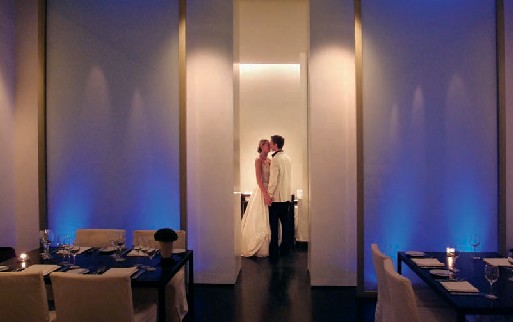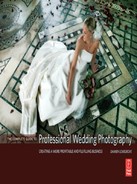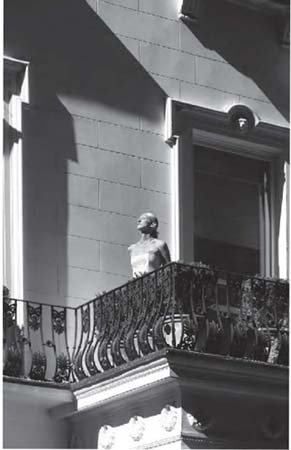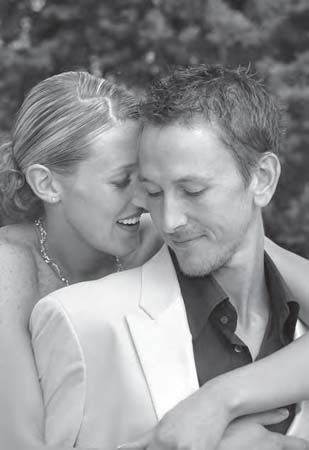Over the next few pages, I’ll be sharing with you a series of pictures that Julie and I shot for an American bride at the famous Hempel Hotel in London. As the hotel is known for its stark, minimalist décor, we all agreed it might be fun to reflect this in the pictures. As a result, most of the images are strong, simple, uncluttered compositions in black and white with a few color shots for contrast. The hard, directional lighting we chose to use also brings out the angularity of the hotel’s interior design. Above all, our aim was to make these images elegant and stylish – just like the bride and groom.
What does wedding photography really mean? When a bride- to-be follows up a recommendation, calls a wedding studio, or clicks the address of a wedding website, what can she expect? There are a wide variety of ‘styles,’ ancient and modern, aroundtoday – with some photographers ‘mixing and matching.’ Here’s a mini guide:
Traditional wedding photography is a record of the occasion: recording the guests, what they look like, what they are wearing, and what is happening on the day. The customers are given a set of formulaic prints that document their marriage. Just like my first attempts, traditional images are well crafted but often lack soul.
Storybook wedding photography is where record photography goes one stage further. All the details and moments of the day are captured, telling the story of the day often through ‘rose tinted glasses.’ Even the bride’s shoes get their own shot! This is still essentially record photography, but usually the ‘people pictures’ take on a less formal style with only a few of the people showing eye contact with the camera.
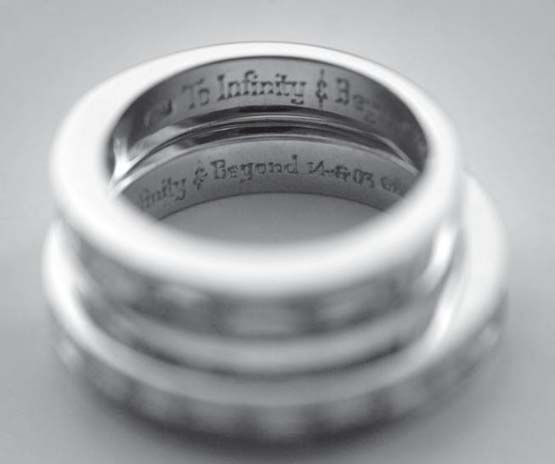
Fig. 2 ISO 800 f/4 at 1/ 500th
It didn’t make it any easier that the inscription was on the inside of the rings! So I used a shallow depth of field to emphasize the message.
Reportage comes next and out goes the rose tinted glasses! The reportage style is meant to show it as it is. Reportage is the purest form of record photography. It is all too easy to do reportage badly, shooting all day to produce nothing of real substance. The great reportage photographers are just that, great craftsmen and women of the highest caliber. They have the uncanny ability to always be in the right place at the right time with the right lens and get the shot in difficult light without being noticed.
Brand or personal style is a departure from record photography. There is a whole gamut of genres labeled with a particular brand or a personal style ranging from mainstream fashion to simple minimalism. This work is the product of a directed photo shoot, an extreme degree of photographer intervention. This is where photographers take control and implement their own unique style. The directed shoot is often made to look natural and as if it really happened without intervention. The key to this kind of work is in the subject itself. Even though a photograph has been totally set up it can have immense value. This style has been the key to our success over the past 5 years. The Lovegrove style is very much in demand and often copied.
The Bottom Line
It’s easy to photograph the bride and groom, but it’s much more difficult to capture the love that exists between them. It’s the ability to shoot love, fun, tenderness, and beauty that makes the work of the great wedding photographers stand head and shoulders above the rest.

The bride was obviously proud of her hair style so Julie made a feature of it with this shot. A blip of flash high above the camera acts as a ‘hair light’ while the pensive expression reflects the gravity of the occasion.
The digital revolution, or should I say evolution?, is here. Some15 years since the world of music embraced digital capture and delivery to the retail buyer, photography has followed suit. Through the ages, photography has reinvented itself several times. With each new phase came a new set of craft skills and opportunities.
In the early days before color, a photographer regarded exposure as only a small part of the process. All photographers processed their own negatives and printed their own images under the enlarger.

Fig. 4 ISO 400 f/4 at 1/ 125th
An interestingly complex portrait: mirrors are great for adding extra depth – and a touch of mystery – to a composition. Here I bounced the flash off the wall behind me: this increases the apparent depth and draws the viewer toward the bright highlight behind the mirror image of the groom.

Excitement and tenderness: you can’t beat expressions like this. Shooting from below the little girl’s eye line allowed me to frame the faces on the same horizontal plane.

Fig. 6 ISO 200 f/4 at 1/ 500th
Everything came together for this pleasing portrait: lovely directional light, strong shapes, and a wonderful expression. It all began with that slatted ventilation duct that was just crying out to be used in a picture!

Fig. 7 ISO 200 f/4 at 1/ 2000th
Sunlight on the balcony picks out the bride. Another color shot in pastel shades – strong saturated colors don’t really go with minimalism!
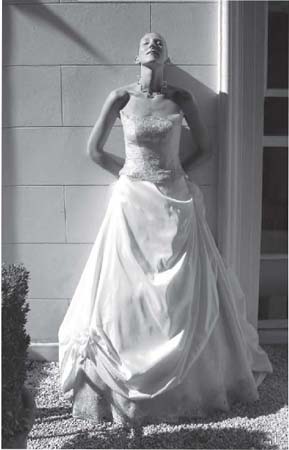
Fig. 9 ISO 400 f/4 at 1/4000th
This is another bold composition in which Julie used the sunlight to create an almost sculptural effect.

Fig. 10 ISO 800 f/4 at 1/ 60th
While Julie is doing her stuff on the balcony, I’m having fun too. Here I have added a spot of light from a 300 Watt tungsten lamp with the barn doors cropped in tight to attenuate the light. It’s easy to get too serious when trying to create cool compositions – raising a spontaneous smile like this can be priceless.

Fig. 11 ISO 800 f/4 at 1/ 60th
with hand held off camera flash. This is one of those shots you couldn’t set up even if you tried: the moment when the bride enters the ceremony room. Julie’s timing was crucial. The expressions, body language, and design are all spot on.
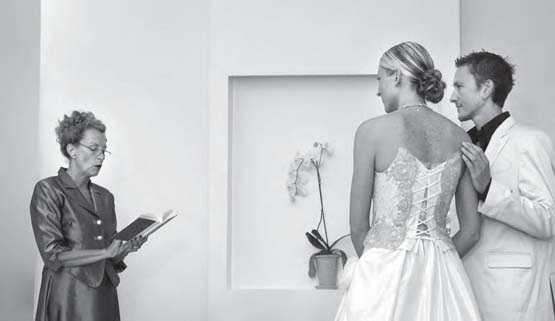
Fig. 12 ISO 800 f/4 at 1/ 60th
Another fine composition with a touch of tenderness against the cool, geometric background.
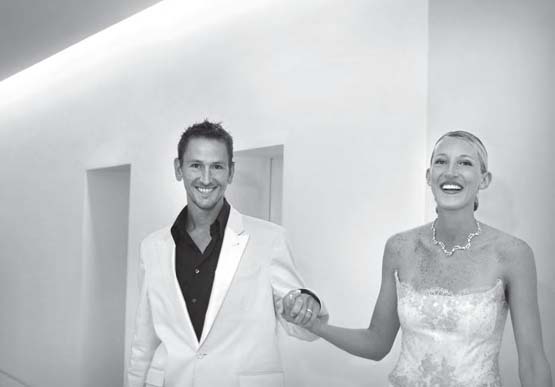
Fig. 13 ISO 800 f/4 at 1/ 60th
As the happy couple come toward me, I’m walking backwards holding a TTL flash in my left hand above the camera. One way or another, it’s a moment of fun and spontaneity {AQ5} which the couple’s expressions reflect.
With the arrival of the color film the professional lab emerged with automated processing and printing. This meant that the printer’s art was lost by a whole generation of photographers who handed their films into the lab on a Monday and picked up their prints a few days later. The color and density grading was done on-screen by a machine operator. The exposure latitude of film allowed photographers to rely on the camera’s inbuilt meter.
With the arrival of digital capture, the roles are once again being reversed with the photographer taking back the control and relearning the printer’s art. It is for this reason a large part of this book explores good working practice and core craft skills. No longer can you leave your camera on auto and leave the rest to the lab! Whether you choose to have a Joint Photographic Experts Group (jpeg) or RAW workflow, some tone grading and color correction will still be necessary by the photographer. This raises a new set of problems of its own. Photographers with some degree of color blindness may not find the switch to digital easy.
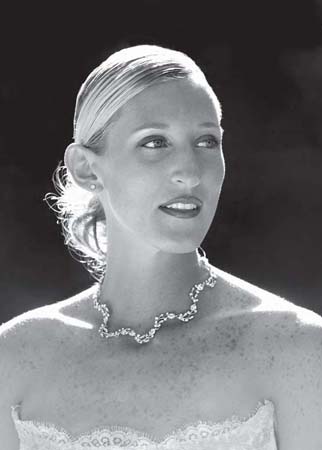
Fig. 14 ISO 800 f/4 at 1/ 700th
A stunning image: the bride was lit beautifully by the late sun shining through some distant trees. We always use Photoshop when an image demands it – in this case the dark bushes behind the bride were rendered to black.
The difference between good amateur photographs taken at a wedding by ‘Uncle Henry’ and those by an official professional photographer is to a large part down to exposure and printing skills. Digital photography is now there for all, and no longer the prerogative of wealthy hobbyists and professionals. Once again we find the craft of photography is back. Professional work is being pushed to new, higher standards to keep the edge over mainstream amateur work.
It can be fun to shoot a wedding in homage to the minimalist style that developed in the 1950s where ‘less is more.’ It does however take a surprising amount of effort to achieve a convincing look. Throughout this chapter, I share with you a set of wedding images in the minimalist style that Julie and I took for an American bride at the world famous Hempel Hotel in London.

Figs 1 5 & 1 6 ISO 800 f/4 at 1/ 180th
Stepping back out of the sunlight of the previous picture and just using the bushes as a backdrop, these intimate moments were set up and then captured spontaneously. Sometimes couples make their own magic!
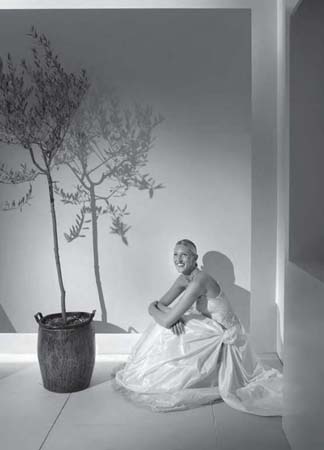
Fig. 17 ISO 400 f/4 at 1/ 30th
It pays to prepare. After setting up my small 300 Watt tungsten spotlight (with barn doors for greater control) on a stand, and planning a trio of shots with Julie, we called in the bride and groom. Panning the light between pictures allowed its stand to stay in the same place while we shot the pre-rehearsed images in quick succession.
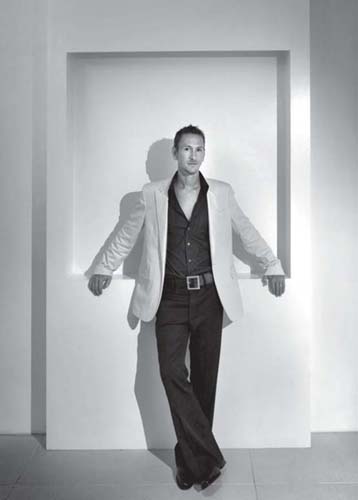
Fig. 18 ISO 400 f/4 at 1/ 11th
Here I created a pool of light for the groom to stand in and placed him right in the middle of the frame just breaking the symmetry with his crossed legs. I always use a monopod to hold the camera steady in these situations.
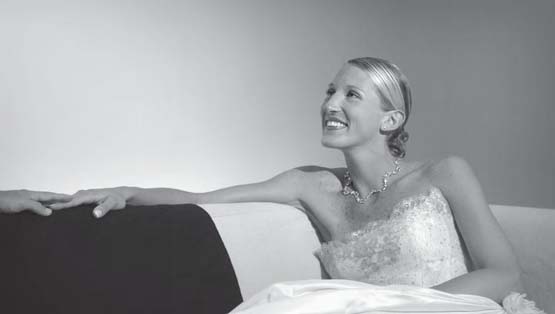
Fig. 19 ISO 800 f/4 at 1/125th
The touch of the hands and the look of love make this image work for me. The light position should have been to the left of the camera but because the barn doors kept the spill from creeping up the wall behind the bride, I got away with it.
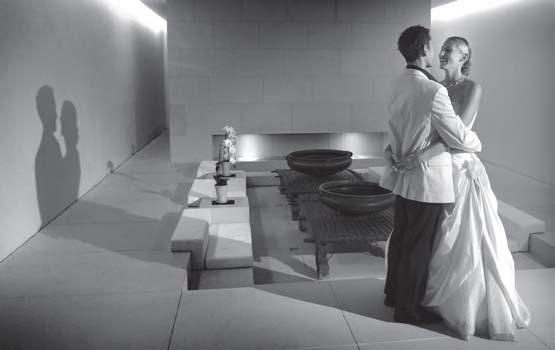
Fig. 20 ISO 400 f/4 at 1/ 45th
Having re-rigged my spotlight in the hotel foyer, we set about having fun with shapes and shadows – carefully controlling just one light with the barn doors. The items in the hotel nearly cluttered the shot but in black and white it’s much less distracting than it might have been in color.
Bringing it All Together
An understanding of the changing role that photography has played in the recording of weddings together with knowledge of the equipment, techniques, and systems of the past help us to understand the current market and predict future trends. Products change too. Albums of prints are always likely to be a key product in some market sectors but increasingly slideshows on DVD and CD-ROM are emerging as the new high value products. Changing attitudes toward artistic copyright throughout the world may well force photographers to offer pictures supplied at high resolution on disk as part of a package dictated by demand.
The pace of change is fast and the way people use digital imagery is changing too. The business strategies of the top wedding photographers will stay positive in such a volatile and changing marketplace. Some photographers will be strong advocates of a classic wedding album aiming to get the investment of the more traditional clients. Other photographers will offer the latest products and gadgets to attract the trendy market. These will include slideshows for mobile phones, digital photo frames, prints on textiles, and multimedia presentations. The weak photographers will resist change with a negative attitude or go with the flow undirected.

Fig. 21 ISO 400 f/4 at 1/ 60th
These images remind me of a love scene from a classic movie – planes of continuous tone cut with slashes of light. As usual I shoot the wide angles while Julie goes in for the closeups. Create the moment once and capture it twice on different lenses from different angles.
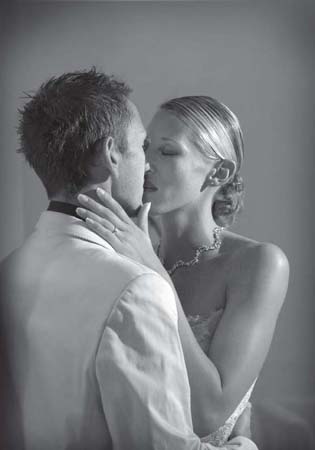
Fig. 22 ISO 800 f/4 at 1/ 125th
Julie’s closeup of tenderness and beauty ends the hotel lobby shoot. Images like this have a very high value to the client, not just for the present but for generations to come. Their children and grandchildren will hold this image in high regard as it shows true passion.
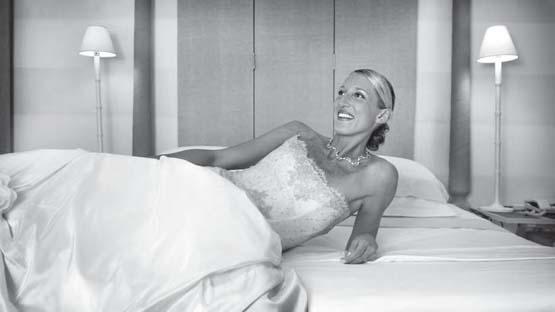
I shot this image of the bride using a splash of flash as the groom entered the room. The moment when their eyes met was the one not to miss.
